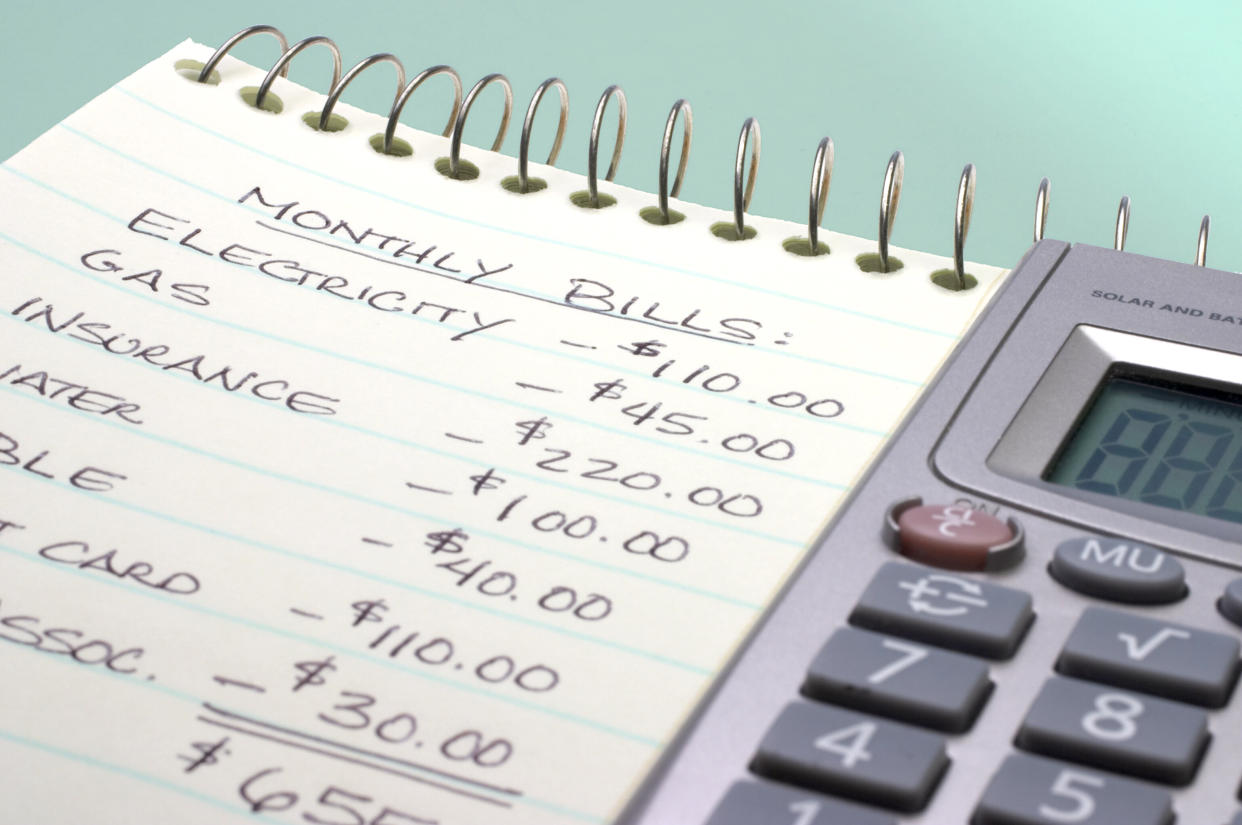Hate The Dreaded 'B' Word? This Simple Budget Template Is For You.

I’ve never liked the word “budget.” It conjures images of penny-pinching and living a life of restriction.
I’m not the only one who feels this way: Nearly 60% of people who participated in a 2018 survey said they don’t track their spending. More than one in three said they spend more than they save, while two in five have never had a budget.
Sometimes I buy an overpriced latte from my local coffee shop. And I treasure my weekly trip to Target, where I never walk out spending less than $50 (OK, maybe $100). But I’ve learned that a budget doesn’t stop me from doing those things. In fact, it’s the reason I can spend money on what I want.
A budget isn’t meant to make life less fun. It’s simply a spending plan ― one that allows you to know exactly where your money is coming from and going so you can reach your goals that much faster.
So if you’ve been avoiding making a budget, it’s time to buckle down and get it done. But don’t worry: We’ve made the process super simple, and even created a handy worksheet to help you get started.
Make A Budget You’ll Actually Stick To
Whether you want to pay off debt, save more money or be able to afford a certain lifestyle, having a budget is the foundation.
“Many people have good intentions to save, pay off debt, etc. However, they plan to do so with what’s leftover at the end of the month,” said Charles Ho, a certified financial planner and founder and CEO of Legacy Builders Financial. “Strangely enough, there is rarely as much, if any, leftover as they had intended.”
Creating a budget is important because it helps you prioritize where your money needs to go before it’s already gone. By seeing your spending patterns on paper, you can identify problem areas and opportunities for improvement.
Of course, that might not sound like such a fun exercise.
“People are often budget-averse or hate even the thought of being on a budget because it makes them feel trapped. It may even make them feel insecure,” said Jeff Rose, a certified financial planner, author and CEO of Good Financial Cents. “That’s why you absolutely must make one that fits your lifestyle.”
So that means keeping things simple. To meet that goal, we created this budget worksheet, which will allow you to get a snapshot of your financial situation without getting too far into the weeds. Print it out or paste it into a spreadsheet, and read on to learn more about how to create your first budget.
How To Organize Your Budget
When it comes time to fill in your budget, it can be helpful to pull up your recent bank account and credit card statements to see a list of all of your expenditures.
Another option is to sync your accounts with a free tool such as Mint, which will organize your spending categories for you. Though there are many tools that will do your budgeting for you, it’s important to go through the process of personally writing out all your income and expenditures first. Think of it like cleaning your house: Sure, you could hire someone to do it, but you won’t truly realize what a mess you’ve been making until you have to clean it all up yourself.
Your budget should include four major categories:
1. Income
Start by adding up all your income. This can include your regular salary or hourly wages and money you earn from a side job or freelancing. For simplicity’s sake, we’ll assume that you’re already having your retirement savings contributions and health insurance premiums deducted from your paycheck. Don’t forget about other non-work sources of income, too, such as child support, alimony or Social Security benefits.
2. Expenses
Next, you’ll probably spend the majority of your budgeting time on tallying expenses. But don’t worry too much about getting into the nitty gritty of how they’re categorized.
“Make sure your four walls are covered first,” said Rachel Cruze, a New York Times best-selling author and personal finance expert. Those are food, utilities, shelter and transportation. “Then, take a look back at your spending from the last month or two and let that help you fill in the rest. You’ll quickly realize categories where you’re overspending (food is a big budget-buster for most people), and it can help to inform what you should budget for categories that aren’t the same month over month, like groceries.”
When organizing your expenses, they should fall into one of three broad categories:
Fixed: Fixed expenses are ones that don’t change month over month. For instance, you know that your rent, internet and Netflix bill will be the same each month. Other fixed expenses might include insurance premiums, child care, a gym membership, etc.
Variable: Your variable expenses will fluctuate each month, so it’s important to keep an eye on them and ensure one doesn’t eat into your other budget categories. Examples of variable expenses include groceries, utility bills, gas for your car and home maintenance costs.
Fun money: Finally, though it technically falls under variable expenses, Rose said it’s crucial to build “fun money” into your budget, which he described as money each person in the household (of appropriate age) has to spend as they wish. “By allowing for this, you don’t feel as deprived,” he said. Of course, the fun money category needs to be reasonable and fit your income and monthly obligations.
3. Debt payments
Next, tally all of your spending that goes to repaying debt, such as credit card bills, student loans, auto loans, etc. Don’t worry about your mortgage payment if you have one, as that’s generally considered a living expense that falls under the “fixed” category.
4. Savings
Finally, you should treat saving money as an expense and include a line item in your budget for it. At the very least, you should be working toward an emergency fund so you don’t have to rely on more debt if an unexpected expense arises. However, you can also include any contributions to a brokerage account, 529 plan or savings fund for a specific goal such as Christmas gifts or travel.
Is Your Budget On The Right Track?
Once you’ve completed your monthly budget, it’s time to evaluate the situation. Tally up all your income, along with all your savings and spending, and input those numbers at the top. What was the overall difference between income and expenses? Did you spend more in certain areas than you planned? Did you meet your savings goals?
Cruze recommends following a zero-based budget, meaning “you spend every dollar on purpose,” she said. So if you ended up with a surplus of cash, or more spending in certain areas than you anticipated, your next step should be to set specific goals for each category. The end result should be that your income minus expenditures equals $0.
What if you’re not sure how much you should actually spend in each category?
Especially for those who don’t want to devise a super detailed budget, Ho recommends following the 50/30/20 rule. Under this plan, which was popularized by Sen. Elizabeth Warren (D-Mass.) in her book “All Your Worth,” 50% of your income should go toward mandatory expenses or “needs,” such as housing, groceries, insurance, utilities, etc. Another 30% goes towards “wants” such as eating out, shopping and entertainment, while the final 20% goes towards savings and debt payoff.
Another helpful guideline is the 28/36 rule. Financial planners recommend that you spend no more than 28% of your gross monthly income (that’s before taxes are taken out) on housing expenses, and no more than 36% on debt repayment.
Again, don’t get too caught up on these numbers if they only stress you out. The number one goal should be to get to a place where your expenses do not exceed your income, and you’re not behind on any bills. Once your finances are under control, you can begin fine-tuning.
Tips For Sticking With Your Plan
Once you finish the process of making a budget for the first time, congratulate yourself. You’re no longer one of the 20% of people who have never done it!
But now comes the hard part: Sticking to the plan. Here are some strategies you can use to stay on track.
Automate: To avoid the painful process of paying bills and transferring money into your savings account, try setting up automatic payments. You’ll be less tempted to fudge your budget if the process happens in the background. But understand that putting your money on autopilot doesn’t mean you don’t pay attention to it. You’ll need to continue checking in at least monthly and ensuring you have the funds in your checking account to cover automatic withdrawals.
Pay yourself first: If you find that your expenses eat into your savings and debt payoff goals, you might need to flip your approach. Rather than taking care of all of your expenses and then setting aside the rest for savings, do the opposite. “The key is to separate the 20% and pay yourself first,” Ho said. “This way, instead of saving whatever is leftover, you are putting that aside first and spending what’s leftover.”
Don’t forget to look ahead: It would be great if all your bills came at regular monthly intervals, but of course, that’s not the case. Some expenses such as auto insurance premiums or travel come every few months. “Open up your calendar and account for things that are out of the ordinary. Maybe it’s a wedding gift or you’re planning for a trip. Whatever it is, think through how that will impact your budget,” Cruze said. You might find it helpful to take the total amount of these types of expenses and divide it by the number of months you have until they’re due, then add that number to your monthly budget.
Use technology to your advantage: Though you should start off by budgeting somewhat manually, it doesn’t have to be that way forever. Rose said it can be helpful to use mobile apps or other technical advances that work with your personality and habits. In addition to Mint, you can try apps like Wally, Mvelopes, Simple or PocketGuard. Play around with different options until you find one that works for you. “Having your finances available on the go and easy to understand will help you stay within budget. With each month of success, you will gain momentum and confidence and comfort with your budgeting,” Rose said.
Check in with a professional: Once you’ve got basic budget down, you might be interested in taking a deeper dive. Things like tax planning, portfolio management and estate planning are key to optimizing your finances and reaching your goals faster. But you don’t have to figure that all out on your own. Hiring a financial planner can help, and you don’t have to commit to a long, expensive relationship with an advisor, either. Many will consult with clients on an hourly or flat-fee basis.
Don’t beat yourself up: Remember that you’re human. You make mistakes ― and that’s okay. Some months will go perfectly according to plan, but some will also end up in the red. Don’t focus too much on hitting your budget goals down to the exact dollar. Instead, pay attention to the trends over time. If your debt is going down, your savings are increasing, and your spending doesn’t get in the way of your goals, there’s no need to sweat the small stuff.
Love HuffPost? Become a founding member of HuffPost Plus today.
Related coverage
The Definitive Guide To Budgeting For Unmarried Couples
How To Calculate DTI, Your Debt-To-Income Ratio ― And Why You Should
Here's What It Actually Takes To Change Your Money Habits
Also on HuffPost
Roll Over Your Old 401(k)

Switch Banks

Negotiate With Your Internet Provider

Complete A Health Assessment

Sign Up For Auto-Pay

Rethink Your Health Insurance

Skim Your Bank Statements

Listen To A Personal Finance Podcast

Switch To A Prepaid Cellphone Plan

Set It And Forget It

This article originally appeared on HuffPost.

